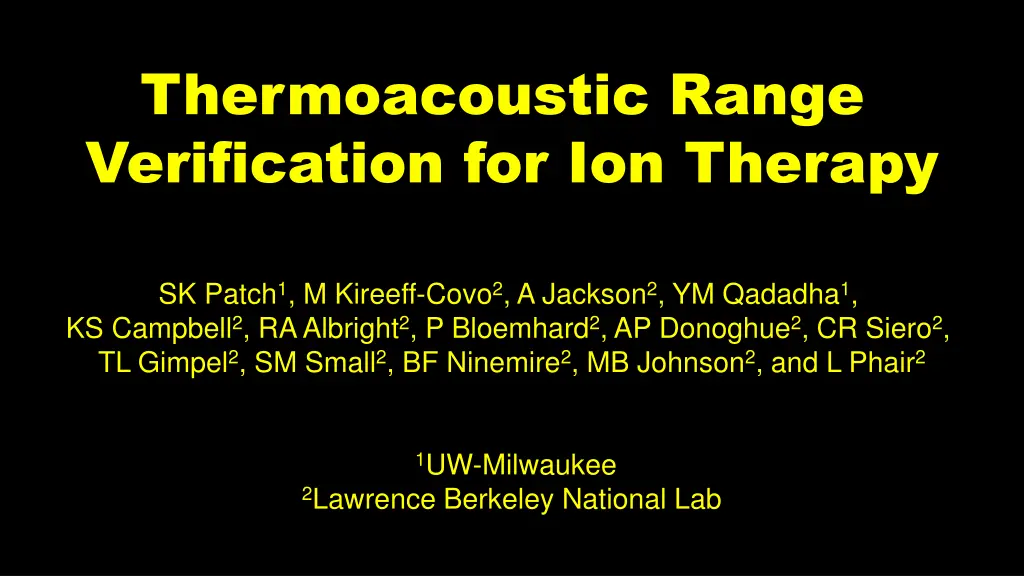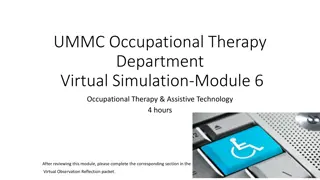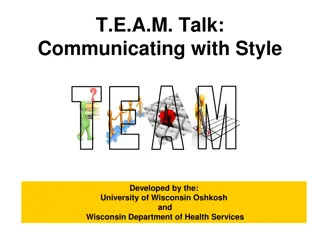
Thermoacoustic Range Verification for Ion Therapy Study
Explore the research on thermoacoustic range verification for ion therapy, focusing on experimental setup, simulations, results in water bath and gelatin phantom, and detector performance.
Download Presentation

Please find below an Image/Link to download the presentation.
The content on the website is provided AS IS for your information and personal use only. It may not be sold, licensed, or shared on other websites without obtaining consent from the author. If you encounter any issues during the download, it is possible that the publisher has removed the file from their server.
You are allowed to download the files provided on this website for personal or commercial use, subject to the condition that they are used lawfully. All files are the property of their respective owners.
The content on the website is provided AS IS for your information and personal use only. It may not be sold, licensed, or shared on other websites without obtaining consent from the author.
E N D
Presentation Transcript
Thermoacoustic Range Verification for Ion Therapy SK Patch1, M Kireeff-Covo2, A Jackson2, YM Qadadha1, KS Campbell2, RA Albright2, P Bloemhard2, AP Donoghue2, CR Siero2, TL Gimpel2, SM Small2, BF Ninemire2, MB Johnson2,and L Phair2 1UW-Milwaukee 2Lawrence Berkeley National Lab
Thermoacoustic Range Thermoacoustic Range Verification inverse source problem Verification - rapid heating (stress confinement) - pressure jump (ultrasound) - time of flight (sonar) 1 Pa = 1 N/m2 = 1 J/m3 = 1 J/kg kg/m3 = 1 Gy in soft tissue = 1000 kg/m3 p = D D Clinical margin: 1 mm + 3.5% target depth
Experimental Setup Accelerator: 88 cyclotron at LBNL 50 MeV protons, lost 1 MeV in ion chamber 2 A for 2 s on target 4.2 mm FWHM beam width 2 Gy/pulse in water target (SRIM) Targets: water in 112-qt LDPE container gelatin phantom mimics muscle (ultrasound) Ultrasound Hardware: clinical array with 96 channels, 300 m pitch 1000 pulses averaged
Simulations Positive (compressional) followed by weak negative (rarefactional) D L 4 pC single-turn 4 pC over 2 s @ 10 MHz 49 MeV: 4 pC in 2 s 4 pC in 6 s Obey stress confinement: Build up pressure faster than it runs away
Simulations Positive (compressional) followed by negative (rarefactional)
Waterbath Results Expect 21.1 mm range - within 1 mm - consistently high - 5 realizations 1 cm left 21.7 0.2 centered 21.9 0.0 1 cm right 22.0 0.02 Patch, et alPMB 2016
Phantom Experiment Gelatin phantom designed to - mimic ultrasound properties of muscle - detect error due to gas pocket s=0.034 s= 0.911 olive oil s=0.998
gel oil Phantom Results Bragg Pk in yellow; entry point in red. Same transducer automatic co-registration of image & range estimate. empty cavity oil-filled cavity distance distal (mm) 64.0 range (mm) 18.7 0.1 27 cavity status N A w/oil 29.3 16.9 0.4 28 B empty
TA Range Ver. take-aways - fast dose deposition increases TA signal strength and bandwidth - off-the-shelf cardiac ultrasound array detected TA emissions from 2 Gy peak, but required overdosing the phantom - custom ultrasound hardware sensitive to TA emissions required to detect within therapeutic dose limits Acknowledgements M Zolotorev & A Sessler, who coordinated first attempt @ LBNL in 2013 Dr. George Noid (MCW RadOnc) provided CT images of phantom U.S. Department of Energy under Contract No. DE-AC02-05CH11231 Verasonics hardware: UWM Instrumentation Grant
Backup Slides - Spectra of TA emissions & transducer sensitivity I(t) spectra advertised sensitivity band suboptimal sensitivity






















